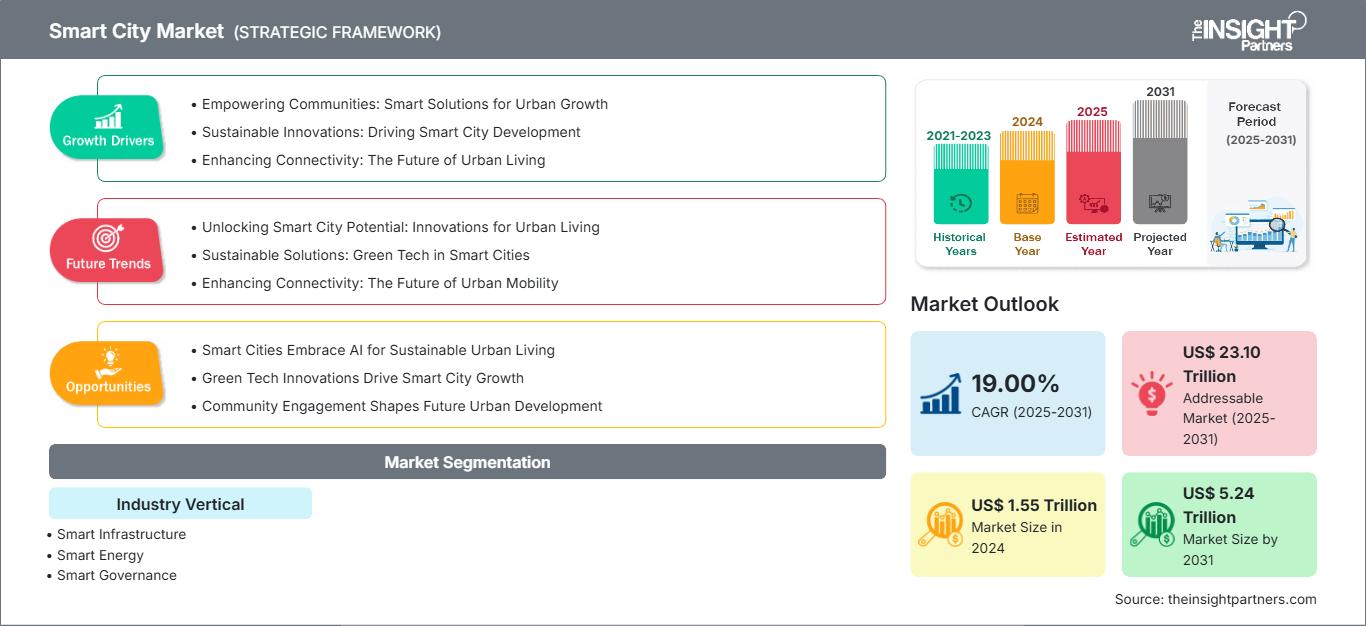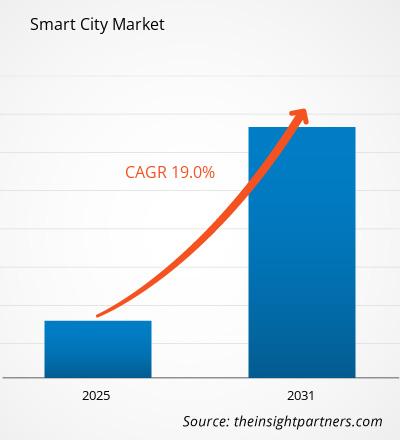Si prevede che il mercato delle smart city crescerà da 1.094,23 miliardi di dollari nel 2022 a 3.110,58 miliardi di dollari entro il 2031; si stima una crescita a un CAGR del 19,0% dal 2022 al 2031.
Le smart city sono un concetto in cui vari aspetti di una città o di una provincia si basano su tecnologie avanzate. Queste città utilizzano la tecnologia digitale e Internet per migliorare le prestazioni dei servizi e la qualità della vita, ottimizzando l'energia e migliorando la sicurezza dei cittadini. Il concetto di smart city mira a sviluppare una connettività e un'infrastruttura robuste per consentire l'accesso alle informazioni in tempo reale e creare un sistema di gestione che colleghi in modo efficiente cittadini, fornitori di servizi e amministratori. Inoltre, il governo garantisce che gli abitanti partecipino attivamente al miglioramento della sostenibilità e della produttività complessiva dei servizi, dotando le città di infrastrutture elementari.
La tecnologia delle infrastrutture intelligenti è cambiata significativamente nel tempo e diverse discipline, come l'automazione degli edifici per la gestione delle strutture e la risposta alle emergenze, l'ottimizzazione energetica degli edifici, la gestione dei parcheggi e i sistemi di comunicazione interni, sono ora ampiamente adottate. Inoltre, le iniziative per l'edilizia sostenibile hanno assunto un ruolo centrale in molti paesi, soprattutto in Europa, Nord America e nelle regioni APAC. L'attenzione alla riduzione del consumo energetico e la preoccupazione per la proliferazione di rifiuti ambientali sono i principali fattori trainanti per lo sviluppo delle città intelligenti. Si prevede che i trasporti saranno un'altra importante area di interesse durante il periodo di previsione del mercato delle città intelligenti.
Personalizza questo rapporto in base alle tue esigenze
Potrai personalizzare gratuitamente qualsiasi rapporto, comprese parti di questo rapporto, o analisi a livello di paese, pacchetto dati Excel, oltre a usufruire di grandi offerte e sconti per start-up e università
Mercato della città intelligente: Approfondimenti strategici

-
Ottieni le principali tendenze chiave del mercato di questo rapporto.Questo campione GRATUITO includerà l'analisi dei dati, che vanno dalle tendenze di mercato alle stime e alle previsioni.
L'esaurimento delle fonti energetiche e la gestione inefficiente delle risorse stanno gradualmente diventando preoccupazioni importanti in tutto il mondo. Ciò sta alimentando la domanda di soluzioni energetiche intelligenti in tutto il mondo. I sistemi di gestione energetica intelligente utilizzano sensori, contatori avanzati, fonti di energia rinnovabile, controlli digitali e strumenti analitici per automatizzare, monitorare e ottimizzare la distribuzione e l'utilizzo dell'energia. Tali sistemi ottimizzano il funzionamento e l'utilizzo della rete bilanciando le esigenze dei diversi attori coinvolti (consumatori, produttori e fornitori). Esistono diverse innovazioni nelle infrastrutture energetiche intelligenti, come la generazione distribuita di energia rinnovabile, le microreti, le tecnologie per reti intelligenti, l'accumulo di energia, la risposta automatizzata alla domanda, le centrali elettriche virtuali e le innovazioni dal lato della domanda come veicoli elettrici ed elettrodomestici intelligenti. Tali innovazioni forniscono una rete estesa di dispositivi energetici intelligenti in tutta la città, con una visione dettagliata dei modelli di consumo energetico, consentendo programmi di monitoraggio energetico basati sulla comunità e migliorando l'efficienza energetica degli edifici.
Analisi regionale del mercato delle smart city
Da una prospettiva regionale, il Nord America ha detenuto la quota maggiore del mercato globale delle smart city nel 2021. L'elevata adozione di soluzioni tecnologicamente avanzate in tutti i settori industriali della regione sta contribuendo alla crescita del mercato nordamericano delle smart city. Il crescente sostegno governativo all'adozione della tecnologia attraverso l'annuncio di sussidi, crediti d'imposta e finanziamenti alle industrie per lo sviluppo tecnologico sta ulteriormente catalizzando il mercato, offrendo così redditizie opportunità commerciali agli operatori del mercato delle smart city che operano nella regione. Ad esempio, nel novembre 2021, il governo federale degli Stati Uniti ha annunciato un finanziamento di 500 milioni di dollari nell'ambito dell'Infrastructure Investment and Jobs Act per superare le sfide delle smart city. Inoltre, la presenza di diversi attori del mercato delle smart city in tutta la regione, impegnati in costante innovazione e sviluppo di prodotti, sta ulteriormente trainando il mercato nordamericano delle smart city.
Approfondimenti di mercato - Approfondimenti verticali del settore del mercato delle smart city
In base al settore verticale, le dimensioni del mercato delle smart city sono segmentate in infrastrutture intelligenti, energia intelligente, governance intelligente, trasporti intelligenti, assistenza sanitaria intelligente e istruzione intelligente. Si prevede che il segmento dei trasporti intelligenti crescerà al CAGR più elevato nel periodo di previsione. I trasporti intelligenti sono infrastrutture di traffico e mobilità innovative basate su nuove tecnologie e progettate per risparmiare risorse e garantire la massima efficienza. Si prevede che l'implementazione di tecnologie chiave come il cloud computing, il 4G, l'apprendimento automatico (M2A) e le operazioni in progetti innovativi diventeranno più comuni nei sistemi di trasporto intelligenti come le ferrovie, fornendo servizi efficienti per passeggeri e merci in tutto il mondo, con conseguente creazione di un bacino di opportunità per numerosi attori del settore nell'ecosistema delle smart city. Ciò attirerebbe anche diversi capitalisti e investitori, portando a una crescita enorme nel mercato dei trasporti intelligenti.
Approfondimenti regionali sul mercato delle città intelligenti
Le tendenze regionali e i fattori che influenzano il mercato delle Smart City durante il periodo di previsione sono stati ampiamente spiegati dagli analisti di The Insight Partners. Questa sezione analizza anche i segmenti e la geografia del mercato delle Smart City in Nord America, Europa, Asia-Pacifico, Medio Oriente e Africa, America Meridionale e Centrale.
Ambito del rapporto sul mercato delle città intelligenti
| Attributo del rapporto | Dettagli |
|---|---|
| Dimensioni del mercato in 2024 | US$ 1.55 Trillion |
| Dimensioni del mercato per 2031 | US$ 5.24 Trillion |
| CAGR globale (2025 - 2031) | 19.00% |
| Dati storici | 2021-2023 |
| Periodo di previsione | 2025-2031 |
| Segmenti coperti |
By Settore verticale
|
| Regioni e paesi coperti |
Nord America
|
| Leader di mercato e profili aziendali chiave |
|
Densità degli attori del mercato delle città intelligenti: comprendere il suo impatto sulle dinamiche aziendali
Il mercato delle Smart City è in rapida crescita, trainato dalla crescente domanda degli utenti finali, dovuta a fattori quali l'evoluzione delle preferenze dei consumatori, i progressi tecnologici e una maggiore consapevolezza dei vantaggi del prodotto. Con l'aumento della domanda, le aziende stanno ampliando la propria offerta, innovando per soddisfare le esigenze dei consumatori e sfruttando le tendenze emergenti, alimentando ulteriormente la crescita del mercato.

- Ottieni il Mercato della città intelligente Panoramica dei principali attori chiave
- Nell'ottobre 2021, Siemens AG ha annunciato l'acquisizione di Squills. Questa acquisizione ha rafforzato le soluzioni di mobilità dell'azienda, come il software di prenotazione e biglietteria.
- Nel maggio 2021, Microsoft Corporation e Itron Inc hanno stretto una partnership strategica per offrire congiuntamente servizi di gestione dei dispositivi mobili (MDM) altamente avanzati ai propri clienti.
Le dimensioni del mercato delle smart city sono segmentate in cinque regioni principali: Nord America, Europa, Asia Pacifico (APAC), Medio Oriente e Africa e Sud America. Nel 2022, il Nord America ha guidato il mercato con una quota di fatturato sostanziale, seguito dall'Europa. Inoltre, si prevede che l'Asia Pacifico registrerà il CAGR più elevato nel mercato delle smart city dal 2022 al 2031.
I principali operatori globali del mercato delle smart city includono ABB Ltd; Cisco Systems, Inc.; Oracle Corporation; Microsoft Corporation; e IBM Corporation. Oltre a questi, durante lo studio di ricerca sono stati analizzati anche altri attori, tra cui Accenture, General Electric Company, Schneider Electric SE, Siemens AG ed Ericsson AB.
- Analisi storica (2 anni), anno base, previsione (7 anni) con CAGR
- Analisi PEST e SWOT
- Valore/volume delle dimensioni del mercato - Globale, Regionale, Nazionale
- Industria e panorama competitivo
- Set di dati Excel
Report recenti
Testimonianze
Motivo dell'acquisto
- Processo decisionale informato
- Comprensione delle dinamiche di mercato
- Analisi competitiva
- Analisi dei clienti
- Previsioni di mercato
- Mitigazione del rischio
- Pianificazione strategica
- Giustificazione degli investimenti
- Identificazione dei mercati emergenti
- Miglioramento delle strategie di marketing
- Aumento dell'efficienza operativa
- Allineamento alle tendenze normative






















 Ottieni un campione gratuito per - Mercato della città intelligente
Ottieni un campione gratuito per - Mercato della città intelligente